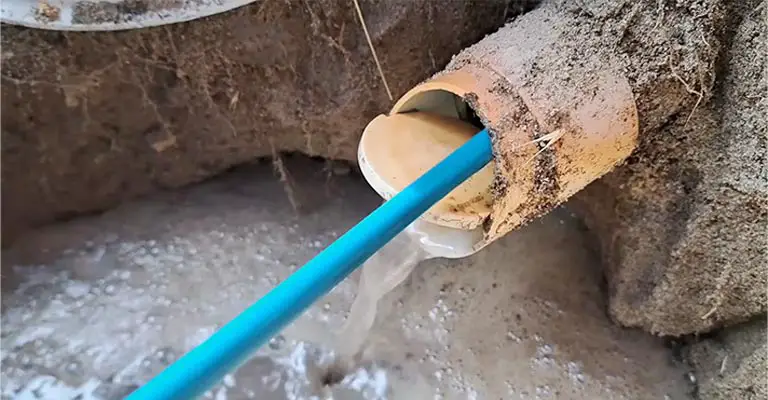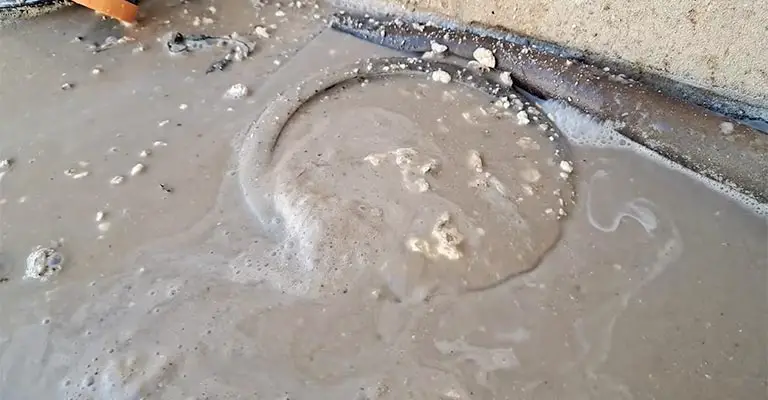Many homeowners do not realize their property has a sewage connection pipe that should be cleaned out regularly.
An access pipe to your main sewer line is usually white in color. You could experience sewage backup within your house or yard if these pipes are blocked or clogged.
If you notice sewage odors outside your home, it is likely that there has been a sewage backup.
There could be sewage in the sewer clean out if you have multiple drains overflowing and backing up, or if multiple drains back up and back up.
It is never pleasant to learn that your main sewer line has broken. Leaving it unattended can result in a number of expensive repairs and high utility bills.
If you need to repair, replace, or clean your septic system, you should do an inspection of your main sewer line before reaching this point.
Causes of Sewage Coming Out of Pipe in Yard
Why do pipes leak and sewer pipes break? Old houses are prone to plumbing problems due to a number of factors, including:
High water pressure – High-speed water zipping through pipes increases the likelihood of them bursting.
Shifts in foundation – Pipes adjust over time as foundations settle, causing ruptures and disconnections.
Tree roots – When small cracks form in pipes, water seeps in, attracting roots to burrow into them.
Temperature changes – Can warm weather cause pipes to burst? Yes, extreme temperature changes – especially cold and hot weather – can lead to cracks and leaks.
Corrosion – Cast iron, copper, and galvanized steel pipes are more prone to corrosion.
There is a 25 to 35-year life expectancy for cast-iron pipes. Sewer pipes over 25 years old are often susceptible to failure – which is another major plumbing issue in old houses.
Cracks and root intrusion may already have damaged your drainage system before you experience a complete sewer line failure.
Do not wait for your piping to completely fail before taking action. In the event of a broken sewer pipe, you should look out for the following signs:
Sewage Blockages & Backups
One of the most common plumbing problems in old houses is this problem in the lowest open drain. Whenever sewage backs up, a blockage in the pipe lines is to blame.
This problem is likely caused by misaligned connections, soil getting into cracks, or roots getting into the pipes, even after you’ve cleaned them.
Sewage Water Pooling in the Yard
There are several causes of this issue, including clogged drains, a broken septic tank, and cracks in the main line. Problem areas are usually located under sewer pools.
Sewer pipes that are broken can cause foundation settlement, cracks, sinkholes, insect infestations, and rodent problems.
Lawn or Under-Paver Indentation
There is a possibility that the soil can dissipate due to a crack in the sewer main line, which consistently saturates the ground. If the line runs through your lawn, it will cause it to dip.
Lush & Extra Green Patches of Grass
You can use this method to determine whether your sewer line is leaking. A sewer pipe leak underground could be the cause.
Fertilizing vegetation with sewage makes the grass greener and lusher because it provides extra nutrients.
Mold
The growth of mold behind the walls can also indicate there is a crack in the sewer line.
In the event of a sewer pipe crack, the humid conditions can be conducive to mold growth. Identifying mold in your pipes and removing it is critical to preventing future problems.
Unpleasant Smell
Sewer gas odors shouldn’t be noticeable because they should be airtight everywhere (except the vent stacks on your roof). Otherwise, your pipes probably have a crack.
How Do You Know If Your Sewer Line Is Clogged?
It is important to look for the cap on the line in order to find the cleanout. An obstruction can be confirmed if sewer water is flowing up through or standing in the pipe.
Find an access point, such as a manhole cover or a floor access point and disconnect the main water supply.
How To Locate The Clog In The Sewer Line?
Essentially, a cleanout is a way to get to a pipe underneath an area of your property.
Dig 5-6 feet beneath the surface and you’ll typically find them close to your front or back door. On top of the ground, a small metal sign will mark the location of the cleanout.
There is a clog in your sewer line if sewage flows straight into your yard from the cleanout, through your sidewalk or from nearby storm drains.
Why Is Sewage Coming Up In The Yard?
It is because something down the main line cannot pass through your clean-out that it is clogged. Detect any problems with your sewer pipe by inspecting it regularly.
A clog in the drains, a broken septic tank or a crack in the main line are the most common causes of sewer line problems. In most cases, the problem area is located under the sewer water pool.
Sewer pipes that are broken can cause foundation settlement, cracks, sinkholes, insect infestations, and rodent problems.
Leaking Sewage In The Front Or Backyard: What To Do
The situation can be remedied by a few steps after you discover a sewage leak in your yard.
1. Contact Your Water Company Or Sewer Company

It is likely that your local water company or sewer provider will be responsible for fix the issue if the blockage is between the main sewer line and the end point of the clean out pipe.
Information about your sewer line can be found by contacting their water utilities department.
Usually, they can locate the cause of the blockage via a sewer video inspection if the blockage occurs between your house and the clean out.
Plumbing specialists can remove clogs or carpeting that’s been mistakenly flushed or carpeting that’s been flushed inadvertently.
Depending on the cause, they may refer you to other departments if it turns out to be a collapsed drain pipe.
2. Do Not Flush Or Use Water

It is very easy for sewage to enter your home as a result of a sewage backup in your yard. Consequently, it is important that you stop using water in your home until the blockage can be resolved.
There will be no showers or toilet flushes. Sewer lines are often shared between several houses, so the blockage can also affect your neighbor.
The neighbor will be able to prevent sewage from entering their homes or yards after learning of the blockage.
You may also experience sewage backup on your property if your neighbor uses more water than you.
The sewage will still overflow sometimes, no matter what you do. In order to protect yourself and your neighbors from sewage spills, you should handle them appropriately and promptly.
It is possible for sewage to spill on your property in rare circumstances. In these cases, you should consult your local health authority before handling the emergency.
Go outside and flush your drains as soon as possible if you are able to do so safely. Water pressure may not be sufficient to flush the pipes, or the flush might cause a flood (for example if you are upstairs), so you may need emergency assistance.
When it comes to sewage waste material, inexperience and poor equipment can pose serious dangers to both people and the environment.
If you attempt to handle your sewage matter yourself, you will only make things worse since your yard and surrounding areas will be affected in unpredictable ways.
3. Unclog the Drain Pipe

There will be a removable cap on the clean out pipe in your yard. This access point can be used to snake out any sewage blocking the drain pipe.
Nevertheless, because the blockage may be too deep, it is probably best to contact a plumber and a sewage cleanup service to remove it.
Besides containing bacteria and infectious diseases, sewage waste materials are also dangerous. Waste materials such as sewage will be disposed of properly by a sewage removal team.
What Is The Cost Of Unclogging A Main Sewer Line?
In general, it costs between $350 and $650 to unclog a main sewer line, but that doesn’t necessarily mean your house will cost the same.
There are a number of variables that can affect the cost of a clog removal, including the size of the clog, the length of time it has been blocked, and whether or not a camera is required.
How Often Should Sewer Lines Be Cleaned?
You should know how often your plumbing should be inspected. A good question to ask is how often your sewer lines need to be cleaned.
Preventative maintenance should be performed every 18 to 22 months. Nonetheless, if you’re experiencing problems more frequently, a video pipe-inspection by a professional plumber is a must.
Who is Responsible for Blocked Sewage Pipes?
Traditionally, lateral drains and sewers connected to public networks were the responsibility of the property owner.
Most of these are now maintained by local water companies. Any problems with your lateral drain or sewer should be reported to your local water company.
Final Words
What is causing the sewage to come up in the yard?
Plumbing fixtures can become clogged more frequently when there is a leak in the sewer line/s.
There are a lot of bacteria that live in your sewer line and seep into your soil and harm your lawns.
Don’t wait until you see sewage coming out of the yard pipe. It will cost you an arm and a leg to repair your sewer pipe!
If you suspect that a sewer line is leaking in your yard, you should consult with a licensed and professional plumber as soon as possible.
The prevention of small symptoms before they become big headaches can be achieved by checking your piping regularly for service.








